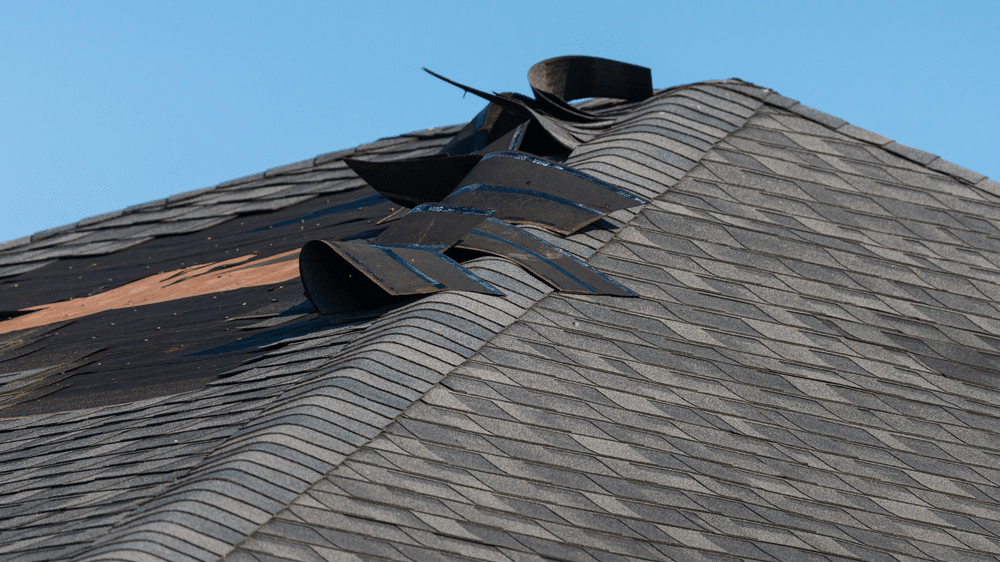A damaged or aging roof is a serious matter. In addition to looking like an eyesore in your neighborhood, it can quietly lead to thousands in water damage, mold remediation, and energy loss. But how do you know when it’s time to replace it versus patching things up?
Here are five of the biggest warning signs that your roof is nearing the end of its life and needs attention soon.
1. Your Shingles Are Curling, Cracking, or Missing
If you stand in your yard and notice that your shingles look warped, cracked, or are starting to curl at the edges, that’s your roof waving a red flag. Shingles are the first line of defense against water intrusion, and once they lose their shape or protective granules, they can’t do their job properly.
Curling shingles often indicate the materials have dried out from years of sun exposure. Cracked shingles usually come from temperature fluctuations — expansion and contraction over time weakens them. Missing shingles are even worse, as they tend to leave your underlayment exposed to direct moisture.
Once this kind of wear starts spreading across large portions of your roof, repairs may only buy you a short reprieve. If it’s isolated to one small section, patching might work. But if you’re seeing widespread deterioration, it’s likely time to consider a full replacement.
2. You’re Finding Granules in Your Gutters
Those small, gritty particles you see in your gutters or around your downspouts aren’t just dirt — they’re likely granules from your shingles.
Granules protect asphalt shingles from UV rays and add fire resistance. Over time, they begin to loosen and wash away. When you start seeing a significant amount of them in your gutters, it’s a clear indicator that your shingles are wearing thin and losing their protective coating.
A roof losing granules won’t fail overnight, but it will degrade faster from sun exposure and water penetration. Think of it like a car tire that’s losing tread — it might still work for now, but it’s only a matter of time before it fails.
If you’re unsure, grab a ladder and inspect a few shingles up close (or better yet, have a roofer do it safely). If you can rub your hand across the surface and granules come off easily, the shingles are past their prime.
3. You Have Water Stains or Leaks Inside
You might not notice roof issues from the outside, but your ceiling will tell the story inside. If you see brown or yellow stains on your ceiling or walls, that’s often a sign that water is finding its way in.
Even a tiny leak can cause significant damage over time, soaking insulation, warping drywall, and inviting mold growth. The tricky part is that water doesn’t always drip straight down from the entry point — it can travel along rafters and beams before showing up elsewhere in your home.
“Most homeowners don’t realize their roof is failing until there’s a major leak, but by that point, the damage is already done,” John McCarter Construction explains. “If you start noticing obvious symptoms, the time to act is now.”
That advice is spot-on. Once you see visible signs of water damage, you’re already past the early-warning stage. Have a roofing professional inspect your attic and roof immediately. They can identify whether a small repair will stop the leak or if underlying structural issues mean it’s time for a new roof altogether.
4. Your Roof Is Sagging or Uneven
A sagging roofline is one of the most serious warning signs of all — and it requires immediate attention.
Sagging typically points to structural problems beneath the shingles, like weakened decking or rotting supports. It can result from long-term water damage, excessive weight from snow and ice, or poor installation. In some cases, it can also be a sign that your home’s foundation has shifted.
You can spot sagging by standing back and looking at your roof from the street or your yard. The ridge line (the top peak) should appear straight and level. If you notice any dips, curves, or uneven slopes, it’s time to call a professional right away.
4. Your Roof Is Simply Old
Sometimes, the clearest sign you need a new roof is age itself. Most asphalt roofs last between 20 and 25 years. If your roof is approaching that range — or you’re not even sure when it was last replaced — it’s worth getting a professional inspection.
Older roofs are more vulnerable to leaks, poor insulation, and storm damage. Even if it looks okay from the ground, hidden wear can weaken its ability to protect your home.
A roof replacement might sound like a big investment, but compared to the potential costs of water damage, mold remediation, and structural repair, it’s money well spent. Plus, a new roof improves curb appeal and energy efficiency — a win if you plan to sell or simply want lower utility bills.
When to Call a Professional
You don’t need to climb up on your roof to assess its condition — and for safety reasons, you shouldn’t. A licensed roofing contractor can inspect it safely and provide an honest assessment of whether you need repairs or a full replacement.
During an inspection, they’ll look for damage to shingles, flashing, underlayment, and gutters, as well as signs of leaks or rot in the attic. They can also estimate how many years your roof has left, helping you plan and budget for the future. Good luck!

